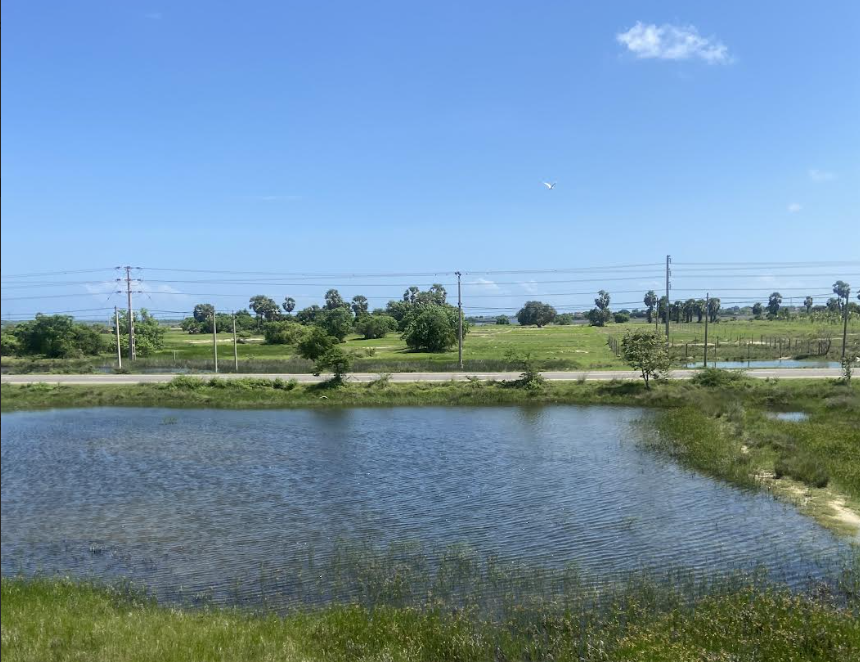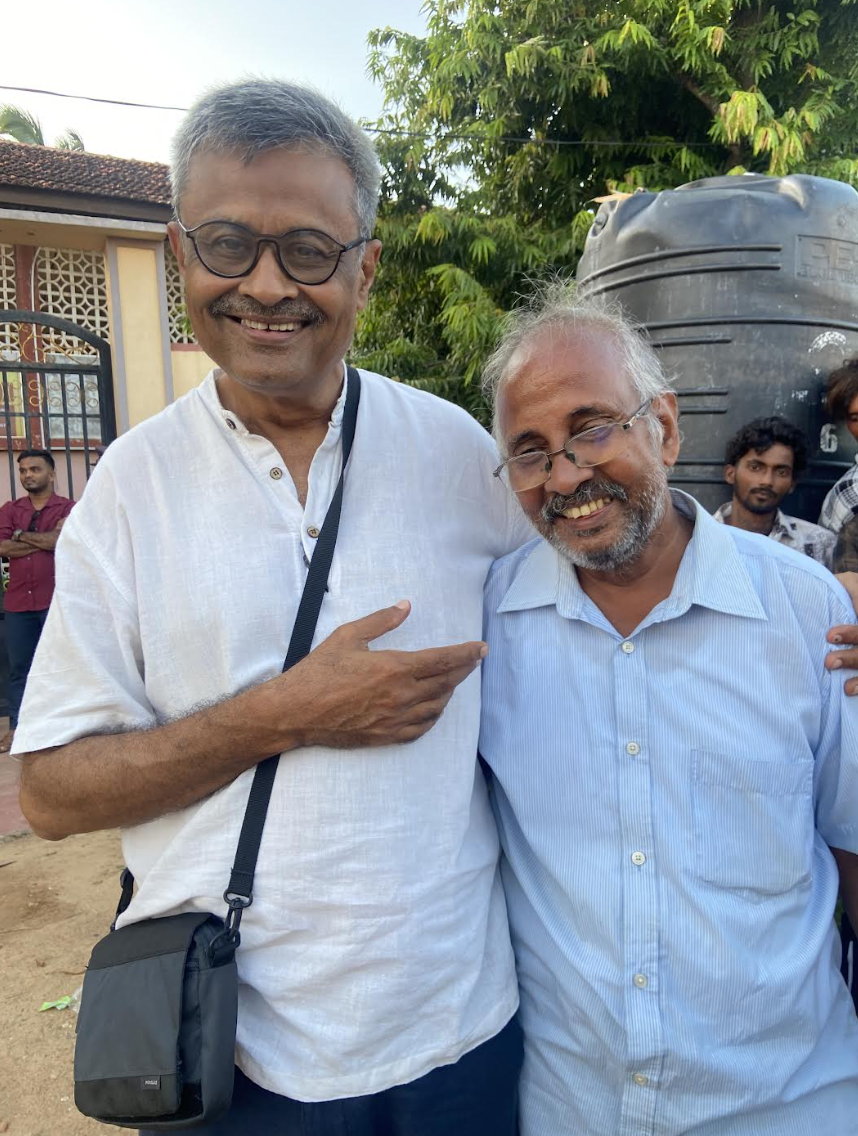A Train to Jaffna
Jaffna: Kilinochchi, Elephant Pass, Jaffna – these names play out in my head more than a quarter century since I was The Hindu’s correspondent in Sri Lanka in 1997. Back then, the Jaffna peninsula and the adjoining Vanni region in mainland Sri Lanka were quite literally killing fields. And Elephant Pass links the peninsula to the mainland.
These were no-go areas, blocked off by the Sri Lankan Army and the Liberation Tigers of Tamil Eelam (LTTE). You could go from Colombo to Vavuniya, where there was an informal dividing line between the army and the LTTE, each maintaining separate checkpoints in their areas of control. All that merged into history when Tiger chief Velupillai Prabhakaran and his cadres were decimated by the Sri Lankan army in May 2009.

Crossing the Jaffna lagoon – the Elephant Pass link. Photo: Amit Baruah.
In December 1995, I was part of a cohort of journalists that travelled in a Sri Lanka Air Force (SLAF) Avro from Colombo to Palali air base in the Jaffna peninsula. We then took a SLAF chopper ride, hanging onto dear life, across the peninsula to Point Pedro. The place was strewn with LTTE memorials and cemeteries; these were later bulldozed by the Sri Lankan state. It was a stop-and-go visit.
Today’s Jaffna is completely transformed. An outsider unfamiliar with its history could very easily believe that nothing happened here. Those who bear the burden of memory, too, have gotten on with their lives, as they must.
Taking an India-made train from Colombo Fort to Jaffna, I wait eagerly for the Kilinochchi station (the former political headquarters of the Tigers). For someone who has been in the business of journalism for four decades, the 11:13 am stop at Kilinochchi is the stuff of suppressed excitement and a rush of adrenaline.
The intercity stop at Kilinochchi station is hardly an event. No one other than me gets down to take a picture of the station – proof that I finally made it to the place I reported extensively about. As I hurry to get back on the train, I can sense the impatience of the Sri Lankan railway staff feeling that their time is being wasted.
We are cruising at nearly 100 kmph when the train breezes past Elephant Pass – the land bridge that was coveted by both the Sri Lankan government and the LTTE during war time. The intercity train refuses to stop there. After crossing the Jaffna lagoon we arrive on the Jaffna peninsula.
It’s a moment to savour, file away in memory, and go back to again and again. I have finally made it to Jaffna, a place I sadly wrote so much about, the centre-point of a bitter war to which we had no access.

People gathered at President Anura Kumara Dissanayake's rally in Jaffna. Photo: Amit Baruah.
The new normal
The Jaffna railway station is neat and clean. I manage a clumsy selfie as evidence of having been here. On the weekend, there are just two trains that come here – including the one that plies all seven days of the week – the Yal Devi Express from Mount Lavinia to Kankesanthurai harbour. The intercity operates only on weekends for some inexplicable reason.
For someone who knows neither Tamil nor Sinhala, the local ride-sharing app, PickMe, is a saviour. My auto ride, booked through the app, takes me to my home stay, quite close to the globally known Nallur Kandaswamy temple. The app helps me navigate the streets of Jaffna,where I meet many friends and acquaintances who returned home after the rout of the Tigers in 2009.

The author with Sritharan Thiruvankarasu. Photo: Author provided.
My home stay is picturesque and comfortable. I eat lunch, a vegetarian thali, at Nallur Bhavan, a stone’s throw away from the temple, which miraculously escaped the bombing and shelling of the war years.
A tourist who hasn’t read up about Sri Lanka will be forgiven if they believe that this is how Jaffna has always been. The roads are good, the shops full and the people going about their business.
I don’t see any military check posts or camps in the town but friends tell me that the military’s presence on the peninsula is still there. The newly-elected President Anura Kumara Dissanayake recently announced that the road from Jaffna to Achuveli would be opened for people to use. People in Jaffna are also keen that the state return their land taken over for security purposes.
A must meet
A person I have to meet is Sritharan Thirunavukarasu, now a Jaffna-based political activist. We have known each other from my Colombo days and followed each other’s lives on Facebook over the years.
We speak on phone to fix a meeting and then bump into each other at President Dissanayake’s Sunday (November 10) afternoon rally seeking votes for the November 14 parliamentary elections.
Sritharan tells me he is supporting candidates put up by the National People’s Power (NPP) alliance of President Dissanayake. It’s a radical change. I bump into others such as veteran political activist Sooriasegaram and Wimal Saminathan, who teaches Sinhala at the Jaffna University.

The author with Rajan and Kiruba Hoole. Photo: Author provided.
It is clearly a time of churn as established Tamil parties must contend with NPP candidates in both the northern and eastern parts of the country. Where this will lead is not clear, but many established parties and leaders are facing uphill battles in the Jaffna electoral district.
Debts that can’t be repaid
Reporters owe a debt of gratitude to their sources and contacts that can never be repaid. One such person to whom I will forever be beholden is Rajan Hoole, co-founder of the University Teachers of Human Rights (Jaffna). He was a voice on the phone for me at first and then began coming to my office-cum-home at Queen’s Terrace in Colombo at short notice.
There was good reason for him to take precautions. His colleague, Rajani Thirangama (35), was killed by the Tigers in 1989. Soon, Rajan and his colleague Kopalasingham Sritharan, went into hiding. They continued bringing out detailed reports on what was happening in the war between the Tigers and the Sri Lankan Army – reports that broke fresh ground and could be relied upon.
A mathematics teacher, Rajan returned to Jaffna in 2009 with his wife, Kiruba, after the defeat of the Tigers. He retired from the University of Jaffna some years ago.
I finally met the couple at their home in Jaffna.
Amit Baruah is an independent journalist based in New Delhi. He was The Hindu’s correspondent in Colombo from 1995 to 1997.
This article went live on November twelfth, two thousand twenty four, at thirty-nine minutes past six in the evening.The Wire is now on WhatsApp. Follow our channel for sharp analysis and opinions on the latest developments.




